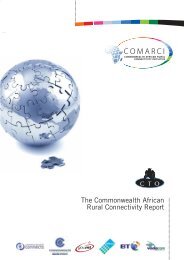Guide to measuring information and ... - unesdoc - Unesco
Guide to measuring information and ... - unesdoc - Unesco
Guide to measuring information and ... - unesdoc - Unesco
Create successful ePaper yourself
Turn your PDF publications into a flip-book with our unique Google optimized e-Paper software.
ED48 Proportion of learners who successfully completed a basic computer skills (or computing) course<br />
at the end of the last academic year (for ISCED levels 1-3)<br />
Definition:<br />
Number of learners who successfully completed a basic<br />
computer skills (or computing) course at the end of the<br />
last academic year, expressed as a percentage of the<br />
<strong>to</strong>tal number of learners enrolled in corresponding<br />
grades where basic computer skills (or computing) were<br />
taught during the last academic year for ISCED levels 1-<br />
3.<br />
Data requirement:<br />
(LBCP) Number of learners who successfully completed<br />
a basic computer skills (or computing) course in<br />
previous grades at the end of the last academic year (t-<br />
1) (by gender, by type of institution <strong>and</strong> by grade) for<br />
ISCED levels 1-3.<br />
(refer <strong>to</strong> questionnaire item E.4.2)<br />
(LBCL) Number of learners enrolled in grades where<br />
basic computer skills (or computing) were taught during<br />
the last academic year (t-1) (by gender, by type of<br />
institution <strong>and</strong> by grade) for ISCED levels 1-3.<br />
(refer <strong>to</strong> questionnaire item E.3.2)<br />
Formula:<br />
t<br />
LBCP g<br />
t 1<br />
g 1<br />
LBCL<br />
* 100<br />
- 80 -<br />
Purpose:<br />
To measure the levels of output of basic computer<br />
skills (or computing) courses in primary <strong>and</strong><br />
secondary schools, <strong>and</strong> their potential impact on the<br />
national s<strong>to</strong>ck of qualifications in basic computer<br />
skills.<br />
Method of collection:<br />
Administrative data collection through annual school<br />
census (or extract data from school records).<br />
Data source(s):<br />
Statistical unit of the Ministry of Education or,<br />
alternatively, the national statistical office.<br />
Where:<br />
LBCP t<br />
g = Number of learners who successfully completed a basic computer skills (or computing) course in<br />
previous grade g-1 <strong>and</strong> who were promoted <strong>to</strong> the next grade g (by gender <strong>and</strong> by type of<br />
institution).<br />
LBCL t1<br />
g<br />
1 = Number of learners enrolled in grade g-1 where basic computer skills (or computing) were taught<br />
during the last academic year t-1 (by gender <strong>and</strong> by type of institution).<br />
Analysis <strong>and</strong> interpretation:<br />
A high percentage or value for this indica<strong>to</strong>r can be<br />
interpreted as a high level of output of basic computer<br />
skills (or computing) programmes in primary <strong>and</strong><br />
secondary schools. It also suggests the potential<br />
positive impact of these programmes on the number of<br />
people with basic computer skills, making a greater<br />
s<strong>to</strong>ck of them available for the economy.<br />
When calculated <strong>and</strong> analysed by grade, by gender, by<br />
type of institution, by geographical regions, by<br />
urban/rural areas, <strong>and</strong> by school, this indica<strong>to</strong>r can help<br />
<strong>to</strong> measure gaps in the s<strong>to</strong>ck of people with basic<br />
computer skills, <strong>and</strong> <strong>to</strong> identify policy issues <strong>and</strong><br />
priorities in this area.<br />
Methodological <strong>and</strong> definition issues or<br />
operational limitations:<br />
Depending on the content <strong>and</strong> country practices,<br />
basic computer skills (or computing) certification might<br />
occur either at a single terminal grade, or spread<br />
cumulatively over several grades <strong>and</strong>/or years.<br />
Metadata explaining such situations <strong>and</strong> describing<br />
the data should be given when reporting related data<br />
<strong>to</strong> the UIS.
















